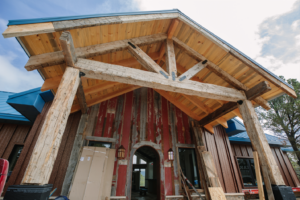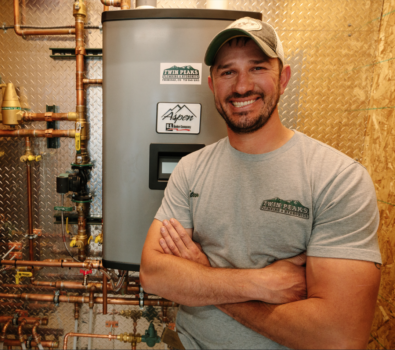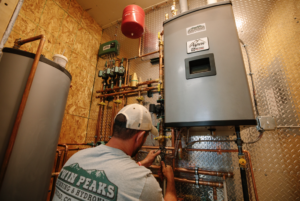By Steve Fernandez
Hydronic Country. What comes to mind when you hear that? New England? New York? Maybe even the northern Mid-West, but likely not the New Mexico-Colorado border.
You might be more surprised to learn that southern Colorado is full of steam systems. Steam showed up here in force just a few scant decades after the Colorado Territory became the Centennial state, and it never left.
I own Twin Peaks Plumbing & Hydronics in Trinidad, CO, and wet heat runs in the family. My childhood consisted largely of Holohan books, green chili, and rides in my father’s service van. My grandfather even installed the first functioning snowmelt system in Trinidad.
Grandpa installed copper tubing in a concrete sidewalk downtown in the 1960s. He had the foresight to coat the tubing in tar, and the system ran for more than 10 years.
The old copper tubing and chunks of concrete aren’t displayed in the Trinidad History museum, but they ought to be. Steam and hot water systems installed by our family can be seen in operation all across the region. In fact, one of my Dad’s last job he completed before retiring was to install a giant steam boiler in the Las Animas County Courthouse.
I’ve been plumbing and installing boilers for nearly 20 years. Four years ago I opened my own shop, Twin Peaks Plumbing & Hydronics, named after the nearby Spanish Peaks. There hasn’t been a boring moment since.
Our time is evenly split between plumbing and boiler work. Boiler replacements are big business, but the new construction referrals roll in at a regular pace, too.

Custom Residences with in-floor heat aren’t a rarity in Colorado, nor for Twin Peaks Plumbing & Hydronics.
Dual residence
A local dentist purchased a hilltop property and immediately began building a small home with plenty of Colorado charm. Steel siding was installed with hopes that it would patina quickly, and plenty of reclaimed wood is used throughout.
The house was a temporary fix; the long-term plan was to keep the structure as a guest home and build a more elaborate residence overlooking the property’s most breathtaking vista. Yes, it has more than one. Twin Peaks was hired to do the guesthouse plumbing, and the owner called on us again last year for the main residence.
This home was ideal for in-floor radiant and a condensing boiler. It’s single-story, slab-on-grade with tile floors, high ceilings and an open floorplan. I didn’t even have to suggest it. It’s what the customer wanted from the beginning.
Over the course of a year, we designed and installed the plumbing and hydronic systems. We got involved early, calculating the BTU load off of blueprints. Twin Peaks installed two-inch foam board insulation with an aluminum vapor barrier under the 2,000 square-foot slab.
The hydronic system is tucked into a small mechanical space – just enough room for a U.S. Boiler Aspen firetube boiler, near-boiler piping and a 40-gallon indirect tank. The 205 MBH boiler supplies heat to three zones, with a fourth zone having priority for DHW.
This was my first time installing the Aspen boiler. Dad and I have used U.S. Boiler products for as long as I can remember, but when I learned that there’s little or no derate needed for the Aspen at high altitude, I wanted to give it a try. We’re at 8,000 feet above sea level here, so that’s a big benefit. With the variety of work we do, it’s nice that the Aspen models run from 85 to 399 MBH.
We prefer to zone with circulators, given that winters can be harsh and access to many of the mountain homes can be questionable during heating season. Taco 007e circulators were used on each zone and the sidearm tank.
Everything went smoothly on this project. The plumbing took longer than usual to complete simply because every element in the home is custom. It will be a great showpiece. The master bathroom is about 250 square feet, with a claw foot tub next to a massive window.
Looking over New Mexico
For whatever reason, it seems that construction takes time in rural Colorado. Another project we were involved with was two years in the making.
The owner of the small, custom log home built the structure himself, meticulously scribing each pine log to the next, even selecting main support timbers that bear the scars of a wildfire.
With three stories above grade, the initial plan to heat the space included in-floor tubing in the lower slab, with light weight gypcrete upstairs. As time went on, fin-tube radiation was selected instead.
The challenge on this job was running the heating loops through the solid log walls after we’d planned on installing radiant. With patience, hole saws and long auger bits, it all came together.
The southwest is notorious for its cramped mechanical spaces, usually due to lack of basement and attic space. This home was no exception. We were again tasked with squeezing an Aspen boiler and sidearm tank into a glorified closet, along with a jet pump and expansion tank to supply potable water. The ability to pipe the Aspen off the top or bottom of the unit is a big benefit.
Two baseboard zones were installed. The open loft area receives enough heat from the hydronic system on the lower two levels, along with two wood pellet stoves that are reserved for use in only the coldest months of the year.
Countless peaks break the horizon while looking out the loft windows. From here, you can see New Mexico.
We’ve been busy since I started the company. We don’t advertise. Las Animas County is a small community, and reputation is everything. The referrals have rolled in at a steady pace and show no signs of stopping.
# # #
Steve Fernandez is the owner and operator of Twin Peaks Heating & Hydronics, LLC., in Trinidad, CO. He has been in the plumbing and heating trade for more than 20 years.


